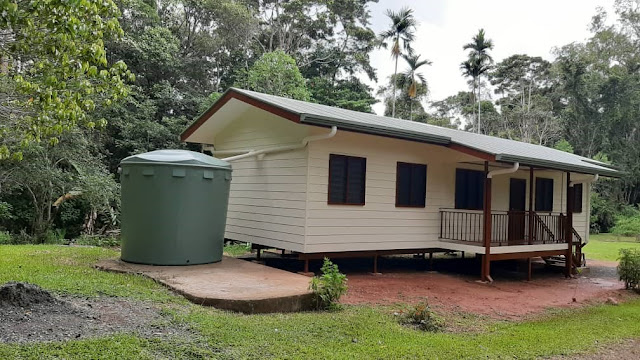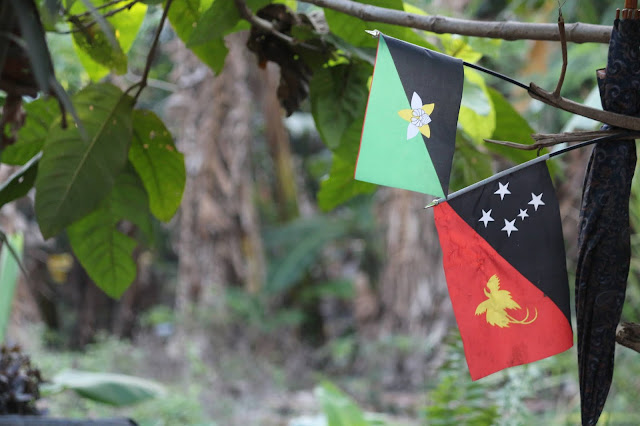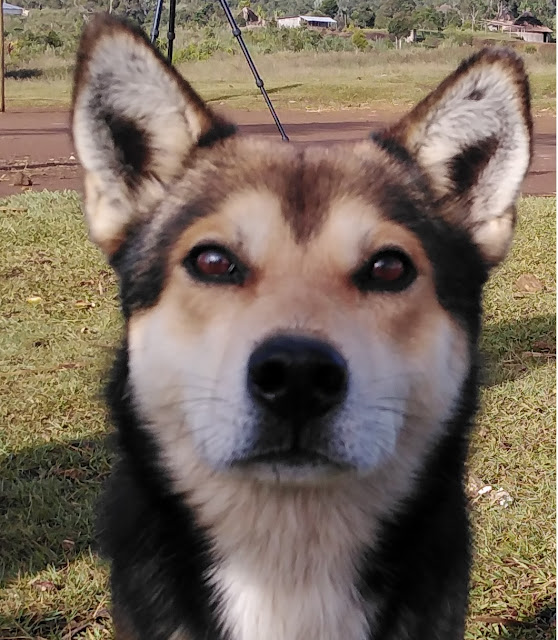The recent trekking adventure to Mt. Victoria, the highest peak in the fringes of Owen Stanley Ranges by the group comprises of Kokoda Track Guides and Porters led by the President – Mr. Norris Selu, Councilor Arthur Danny of Mainumu Ward, Nick Jerry of Koma Village and PNGTPA officers (Wilfred Parka and Naithan Lati) was an adventure set to roll into a world of varied experiences, challenges and encounters at different atmosphere levels when ascending and descending each elevations. The uneven sister ranges of the famous Owen Stanley Range between Central and Oro Provinces have the harsh weather conditions that were unavoidable during the 8days return trip.
In average, we could trek for 4-5hours covering almost 7kilometers a day but it was not that easy for everyone of us. Each day, our day starts with climbing to an elevation level of 2500 -3000 meters above sea level and descending to gorges and valleys at 800 meters above sea level. Only the determined trekkers would overcome such challenges and we were starting to gather our strengths when into the thick jungle separated by ranges with rivers down the gorge. We wanted to make our climb to the summit of Mt. Victoria a success story as a PNG very own team of trekkers.
The now Mt. Victoria was locally known as Anaka in the Koma language which means ladder mountain to the locals. It is located 75 kilometers north-east of Port Moresby and was first ascended by the New Guinea British Administrator Sir. William McGregor in the 1889 and renamed it Mt. Victoria in honour of Queen Victoria.
Until then, some ascends were made by colonial administrators and locals but details are sketchy at the moment. There is no proper tour operator to Mt. Victoria to date even its within interconnecting ranges of Kokoda’s Owen Stanley Range and Kokoda Trail. There are no proper tracks been established apart from few decade old hunting tracks rarely used by the native landowners of Koma Village on the Kokoda side.
There were few special adventure trekking undertaken to Mt. Victoria by individuals with the assistance of the locals. One such group was led by Australian born adventurer Alice Ride who openly expressed her near dying experiences from hypothermia; ‘I was so happy I could’ve cried, but so exhausted and dehydrated that the tears never came;’’ Alice Ride wrote on her blog under passion passport.
Her experiences of the trek and summit at Mt. Victoria were extremely terrifying but she was happy that she visited such a beautiful place in PNG and returned home safely despite some circumstantial issues on the trek that had nearly taken her team into a mishap and evidently stated by herself on the blog;
‘’Not only had we made our way through the night to find our campsite and all of our porters, but we had survived the cold and wet of the storm, too. It felt like a miracle. We were alive and we were safe.’’
The story and experiences of Alice Ride sounds astonishing but adding my personal experiences of Mt. Victoria trekking onto it makes a completely different to relate by a second person and my team's was different. Nevertheless, after been trekking to Mt. Victoria and having to experience the similar kind of odd situations on the trek, I’m relating to her experiences very well and would have not preferred to go if I did read her experience of Mt. Victoria on the blog earlier. However, I read it after the trekking to compare experiences of previous trekkers and her team's visit was so recent with terrifying experiences.
Arrived into Koma Village from Popodetta town after 2hours 4WD ride, the village located near the foothills of Mt. Victoria where the trek starts up a ridge with Koma River that flows out of Mt. Victoria into the Kokoda valley separating the village from the midmountain forests. The trek to Mt. Victoria starts on the ridge that leads to many peaks that have less oxygen levels.
The village elders welcomed us the trekking team to the village in the afternoon from Popondetta town. We had a good chat with elders and previous trekkers to the mountain ranges who shared their experiences to give us fair knowledge of the trek and the jungle before the trekking starts next day. The night was chilling and local dinner was served to us inside a campsite like shelter. At the dinner, the elders would warn us of some customary protocols that needs to be observed strictly all the time in the jungles leading up to the summit. The summit and its environment has its own strict customary rules to adhere to or you face the nature with harsh weather conditions that leads to mishap.
We were told of some scared sites and warned of its importance with a number of unique myths linked into it which we have to respect with strict protocols whilst at the site or face the worst in the jungles for not paying attention to it.
The trekking team arrival news spread and excited communities and people came in numbers to welcome us the new faces in the village. The locally prepared food kept coming into our temporary home. The young boys from the community continued to remain in the shelter with us and telling stories of their past adventures of the mountain from the last ten (10) and three (3) years of respective trekking with one including Alice Ride's team.
Among those stories was one that Alice Ride wrote on her blog which took more than 10days maximum and nearly the team ran out of food rations on the trek and some locals found their own way home early and sent rescue mission with local food items which saved all the remaining trekkers and locals at the camp sites in the jungle.
Our trekking was then preplanned and we were set to roll off early in the morning. The trek goes up hill beside Koma River and our first camp was to be setup at a hunting campsite for the locals but rain caught up with us quarter way to our first camp which was at an elevation of 1700meters above sea level after covering 6hours of climbing the hill for nearly 7kilometers.
The local boys quickly secured an open space under the canopy whilst racing against the heavy downpour. We tied the canvass to some makeshift poles and started the fire to boil hot water for tea to warm ourselves. Our tents were later installed under another canvass away from the fireplace.
It was a cold evening with rain droplets continuously falling from the canopy, we dosed off early to our respective tents after dinner at the campsite. The cold and wet after the rain was unbearable in the first camp but somehow, I managed to get some sleeps to wake up in time for the first bird’s signal in the forest. Was a first beautiful morning away from usual noises in the villages and towns.
The next day weather appeared to be fine and excitement grew over the breakfast time. We packed our camping gears and headed for some greater heights. The locals advised us that; we will be leaving the last of the flowing creek or water from our first camp and rest will be natural ponds or fresh water from bamboos and rock pools as well as ground ponds from moss runoffs. We fetched fresh water and filled our personal water bottles together with water for cooking and climbed the hill for another 7kilometersto get to the next camp which was approximately 2500meters above sea level.
The first team on the trek reached the designated camp at 3pm in the afternoon and the weather was clear for some minutes and we could get a good glimpse of Kokoda Station as well as a chance to see planes landing and taking off from the Kokoda Airstrip. It was an amazing experience of its own.
It feels like looking down into a territory of ants when looking down to Kokoda Valley from an elevation of 2500m above sea level. The farm machineries for the Kokoda Oil Palm Plantation and people moving around appears like ants. The clear view was up for few hours and then clouds taken over the space and it started raining as we retreated into our canvas shelter to keep ourselves dry and warm.
The night was very chilling and windy which made some of us restless. The next day, local boys got up early with their usual jokes by the fire and boiled hot water for tea. During the breakfast the team renamed the campsite after PNGTPA which sponsored the group for trekking to Mt. Victoria as well as for respect and recognition of two PNG officers in the trekking group.
On the third day we could not see any sunlight as clouds covered the area in the morning and sky was grey. Despite the weather, we were ready to climb one of the highest peak along the range which local people call it Mt. Kawa which means out of the place mountain in Koma language.
As we were climbing, the atmospheric pressure appears to be changing and the air became very thin towards the top. Plans were short and covered with mosses where water was dripping continuously making the trek uphill wet, muddy and cold. We could not take those usual steps in climbing but slow steps to grasp for air from a temperature running between 10 and 15 Degree Celsius. It was a scary experience for me and I did not wanted to tell anyone of how I was feeling up there. Deep within me, I was scared of rain catching up with us there under such temperature. I was imagining how cold it would be with rain pouring down on such a place with low temperatures. However, while seeing the local porters without proper trekking gears and trekking beside me gave me some courage to push to the limits with the aim to reach the next camp safely.
It was unbelievable for me to see the local boys with plain clothes and casual shoes or some without shoes (bare foot) trekking with us but they were born to live in such harsh environmental conditions and it was normal to them. Undeniably, the local boys have been through alot of harsh weather conditions because all they need for livelihood sustenance comes from the forests we were trekking through to Mt. Victoria. That is their natural habitat supplying and sustaining their livelihood needs.
The cold temperature was unbearable at the peak of Mt. Kawa and I asked for quick descend to a warmer location for camp and make fire. I could feel my toes going numb inside my shoe and if to remain idle for more minutes would mean being frozen to death or worst.
We quickly ascend to a valley at 800m above sea level. The campsite has been used by the locals on hunting trips. The rain droplets from the treetops of the previous rain felt like rain too and then rain fell afterwards as we made our way to the campsite. We got used to the weather conditions and our team's aims were to set up tents quickly as possible and start making fire to keep ourselves warm and dry.
It rained whole night and the weather was not on our side. Some of us were worn out from the 3days on the trek and another two more campsites to go before Mt. Victoria summit. There was no happy moments with sunshine in the forests leading to Mt. Victoria. Our camps and tracks were all under the cover of the canopy and afternoon rains with clouds that could not show us any blue skies above us.
On the 5th day, after a weary and exhausted trip to the Camp Team Anaka where the helipad was built by the trekking team, we had a little bit of sunshine but wind was very chilling and place was still cold under the sun. The wind could blow the clouds around to cover the area in a rapid scene and then rain was the next expected weather in the area.
The next day we made it to the rocky grassland and explored Mt. Anaka which is on the eastern edge of Mt. Victoria whilst the labelled peak point was only 1kilometer away on the same rocky range from where we were. It appeared to be a clear day but the misty wind with the clouds blew against us and that is the time we lost our tracks at the top of the mountain ranges of Mt. Victoria.
I sensed that we were facing the nature for disobedience and not observing the strict protocols at the site.
The misty clouds were too low for us and we could not see though the tracks leading to the campsites or to the peak. It was very chilling and cold with the misty rain continued with very strong wind. The ground below us was wet with patchy cold water ponds. We all got wet as well as our bags and camping gears.
We regrouped at the peak and agreed to retreat to the hillside and camp rather than advancing to the peak. Lucky enough we quickly descend to a flat rocky hillside and setup tents there and made fire. The misty rain and wind had no mercy on us, maybe because we failed to observe some customary protocols or because we were carless and ignorant at site. We had to face the worst of our adventure there, the ground water ran into our fireplaces twice in the tents and fire died. We all fear dying of hypothermia as per Alice Ride’s experience.
I was scared, I asked for nature's forgiveness and asks each one of the person in the group to admit their mistakes onsite and save us all.
No option was there to guaranteed us all to be safe from the scary cold temperature with misty rain that is no different to snow when it landed on our clothes. Fear of seeing the worst in the cold, I took the initiative to setup the tent on a flat rock area, diverted the ground water away and then reinforced the canvass with the porter’s bags with cargo on one side and other side of the canvass was tied on to the little trees on the hillside. The area was secured and then we transferred the other camping gears into the shelter and made fire inside. A safe place was secured to confess to the nature so that nature can spare us a night there and keep us all safe from the misty rain, wind and the flooding ground water.
There was no place for anyone to sleep inside the shelter, we had one fireplace that provided little heat as it was surrounded by everyone of us and confession to the nature started in the circular order. We truly were into danger. We all admitted our wrongs on the trek to the summit and then had a sinful prayer. After the prayer the wind slowed down and our fireplace remain dry throughout the night.
An experience I will never forget for spending the whole night sitting under the glowing fire with smoke until dawn.
We confessed to the nature for not adhering to the protocols of the mountain and we made the decision to turn back to the Camp Team Anaka the next day and we started to build a helipad at the base of the hill.
After the pickup helicopter was unable to make it to the elevation of 3200m above sea level, there was no option but for all of us to walk back to Koma village on the same trek.
The endurance and sacrifice were realities one will come to realize it in such a harsh condition in the mountain ranges miles away from homes where all comfort is there than having nothing in the forests. We opted to break teams into two with one team going home early to bring additional food supplies back to the second team who were worn-out and exhausted to trek long distances on the return trip.
On our return trip we skipped all campsites with one overnight camp and arrived at Koma Village safely in the afternoon after eight full nights on the track. The return trip was easy because most of the track was ascending the ranges all the way to the village. So the ascending took only 2nights to arrive in the village.
It feels better to write a story with experiences to tell others of our adventure but what individual trekkers have actually gone though during the day and nights on the track to Mt. Victoria is an experience of a life time worth telling and sharing from time to time.
It now compels me to write and share the experiences from our own PNG perspective with the situations and conditions of the track to Mt. Victoria from Kokoda side rather than someone else will write to tell me of my own country about such a wonderful and different world that exists at Mt. Victoria in Owen Stanley Ranges.




















